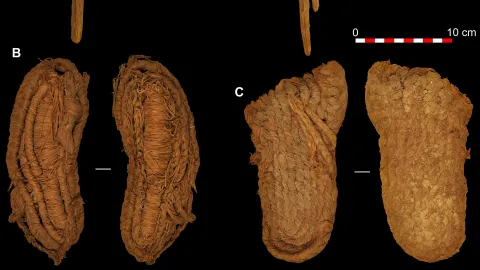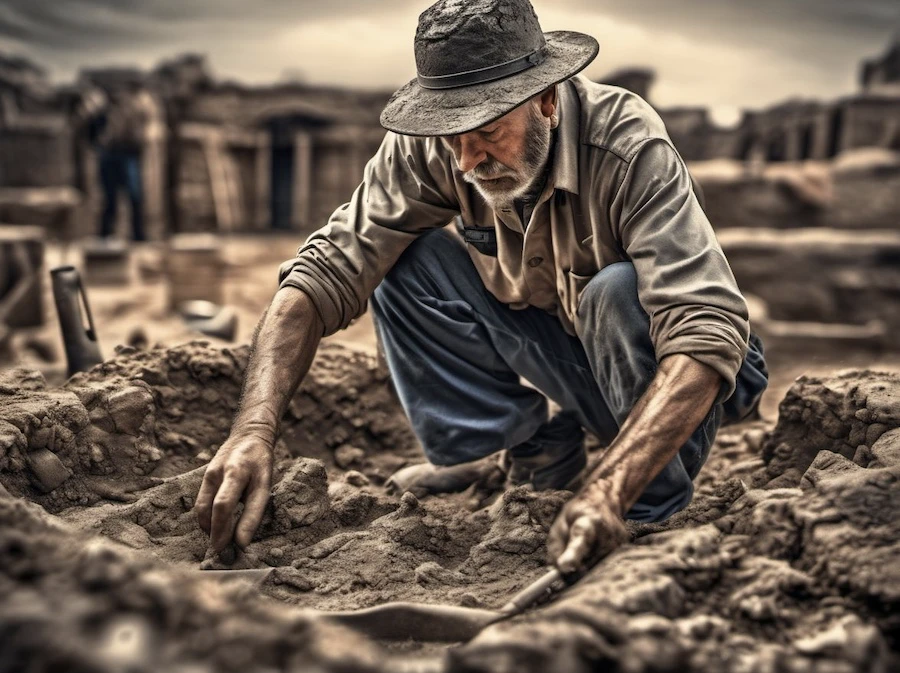September 29, 2023- 3RD OF 3
Walking Through Time: Europe's Oldest Shoes
Martínez-Sevillaet al.,Sci. Adv
In a recent archaeological breakthrough, researchers have unearthed a remarkable piece of European history—a collection of 6,000-year-old woven sandals found in a cave in southern Spain. Published in the journal Science Advances, this discovery is shedding new light on the lives and craftsmanship of prehistoric communities.
The Discovery
Led by a team of researchers from the Autonomous University of Barcelona and Alcalá University in Spain, this groundbreaking find involved the meticulous analysis of 22 woven sandals. The key to their age was radiocarbon dating, which pinpointed their creation to six millennia ago. These ancient shoes were not alone; they were discovered alongside Mesolithic baskets and a variety of tools, offering a comprehensive glimpse into the past.

Martínez-Sevillaet al.,Sci. Adv
Preservation in Dry Conditions
What makes this discovery all the more remarkable is the cave's extraordinarily dry conditions, which proved ideal for preserving perishable materials. Beyond the sandals, the cave harbored a prehistoric burial site, complete with partially mummified corpses, more baskets, wooden tools, and other goods. It's as if time had stopped, allowing us to peer directly into the lives of ancient peoples.
Significance of the Findings
María Herrero Otal, one of the study's authors, aptly describes these objects as "the oldest and best-preserved set of plant fiber materials in southern Europe." This discovery underscores the incredible craftsmanship skills possessed by prehistoric communities. Crafting such intricate woven sandals six millennia ago is a testament to the resourcefulness and expertise of these early European societies.
A Historical Journey
The sandals' journey to the present day is itself a captivating story. They were initially discovered in 1857 when the cave fell victim to looting by miners. Yet, when initially dated in the 1970s, they were mistakenly believed to be about 1,000 years more recent than this latest analysis has revealed. The passage of time and improved scientific methods have allowed us to correct this historical oversight.
Composition of the Sandals
A closer look at the sandals reveals their composition, which is a blend of grasses, leather, lime, and ramie bast—a natural fiber. This intricate combination of materials showcases the resourcefulness of ancient shoemakers.
Burial Customs
Based on the descriptions provided by Spanish archaeologist Manuel de Góngora y Martínez, the study posits that these sandals were often worn by the deceased when they were buried. Some sandals show clear signs of wear, while others seem to have been created specifically for this solemn purpose, shedding light on the burial customs of the time.
Implications for Understanding Early Societies
Beyond the sandals, the study delved into the examination of several baskets and wooden artifacts. These findings challenge previous assumptions about the complexity of Early-Middle Holocene populations in Europe. They suggest that prehistoric communities had advanced knowledge of local plant resources and exhibited a high level of expertise, questioning simplistic views of ancient societies.
The discovery of these 6,000-year-old sandals and accompanying artifacts provides invaluable insights into the craftsmanship, customs, and burial practices of ancient European communities. It challenges our understanding of prehistoric societies and their abilities, highlighting the importance of reevaluating historical artifacts with modern techniques. Walking in the footsteps of our distant ancestors, we uncover a rich tapestry of human history that continues to amaze and inspire.

















































.webp)
.webp)














































